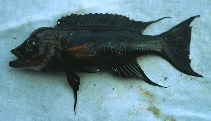| Family: |
Cichlidae (Cichlids), subfamily: Pseudocrenilabrinae |
| Max. size: |
15 cm TL (male/unsexed) |
| Environment: |
benthopelagic; freshwater, |
| Distribution: |
Africa: endemic to Lake Tanganyika, lakewide distribution (Ref. 95525). |
| Diagnosis: |
|
| Biology: |
Solitary; lives in dark recesses of rocky habitat; moves on vertical sides of large rocks or on undersides of overhanging rocks with belly very close to substrate and using large pectoral fins; feeds on macro-invertebrates like crustaceans and insect larvae which are found in the slits, cracks, holes and crevices of their habitat (Ref. 7343, 46829). Always observed in shady parts of rocks; might be nocturnal; large eyes may be adaptation for enhanced night vision (Ref. 95525). |
| IUCN Red List Status: |
Least Concern (LC); Date assessed: 31 January 2006 Ref. (130435)
|
| Threat to humans: |
harmless |
| Country info: |
|
Source and more info: www.fishbase.org. For personal, classroom, and other internal use only. Not for publication.

